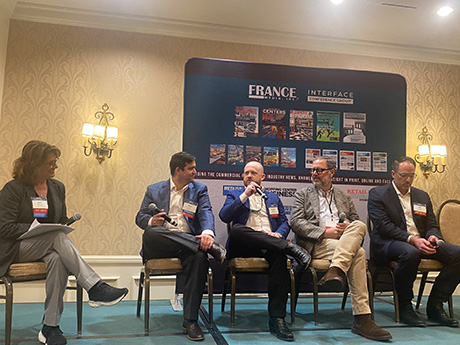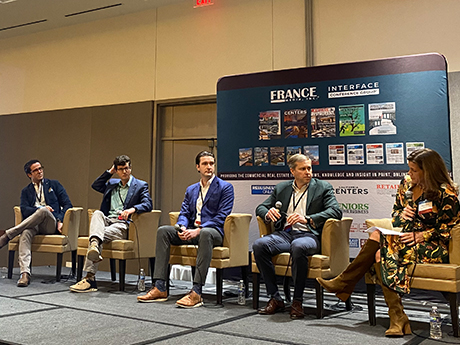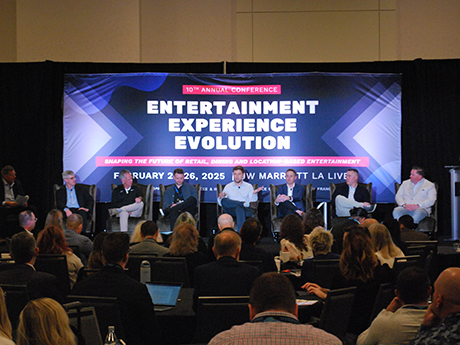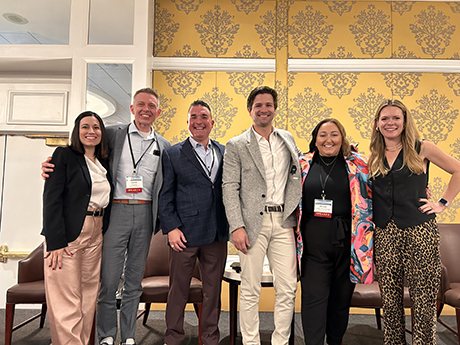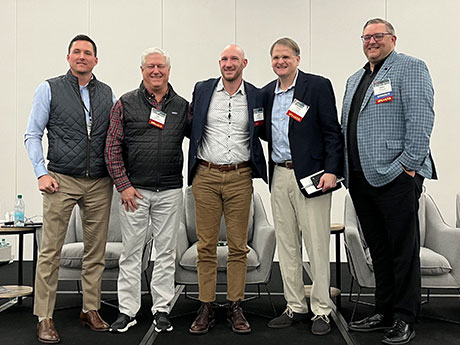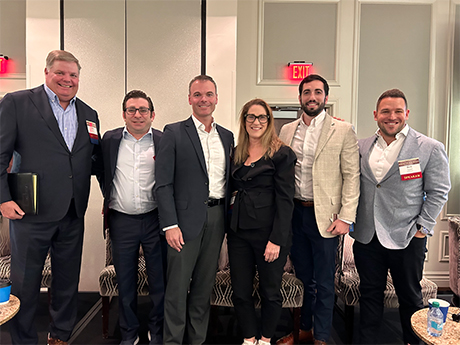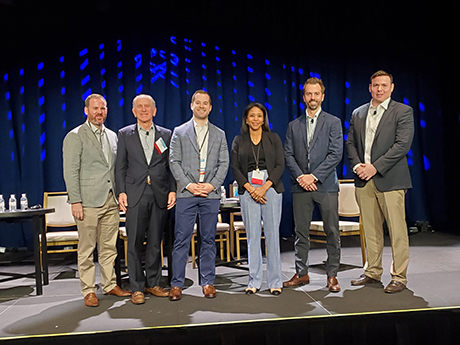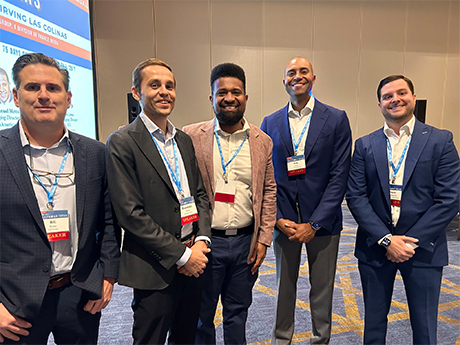By Taylor Williams SAN ANTONIO — Automotive parts manufacturers and data center operators both represent major sources of demand for industrial space in San Antonio, as well as major consumers of electrical resources. Both sets of users are increasingly prioritizing access to cheap, abundant electricity in their site selection and other real estate decisions. But that’s about where their similarities end. For the automotive industry has been a source of job growth and retention in the San Antonio area for decades, whereas data centers are a relatively new phenomenon that offer minimal contributions to local employment. And in between the two on the spectrum of industrial end users are third-party distribution and logistics companies, which really represent the market’s bread-and-butter tenant. But these groups typically don’t have such taxing power demands. Editor’s note: InterFace Conference Group, a division of France Media Inc., produces networking and educational conferences for commercial real estate executives. To sign up for email announcements about specific events, visit www.interfaceconferencegroup.com/subscribe. For data center developers and users, the need and demand for affordable, plentiful power is nothing new. And the fact that Texas has long had its own deregulated power grid has contributed mightily to the state landing many of those …
Conference Coverage
By Taylor Williams DALLAS — As is the case for many commercial asset classes and markets in 2025, there is an expectation of elevated deal volume for investment sales of affordable housing properties in Texas. But brokers in that space caution that the rebound will likely be marginal and is not necessarily indicative of ideal market conditions taking hold. A quintet of panelists broke down this notion and others at the InterFace Texas Affordable & Workforce Housing conference on Feb. 13 at the Westin Galleria Dallas hotel. Mary Ann Bennett, senior managing director at BBG Real Estate Services, moderated the discussion on investment sales activity. Editor’s note: InterFace Conference Group, a division of France Media Inc., produces networking and educational conferences for commercial real estate executives. To sign up for email announcements about specific events, visit www.interfaceconferencegroup.com/subscribe. Panelist Michael Furrow, senior vice president of affordable housing at commercial finance firm BWE, took the audience of 200-plus back in time to illustrate just how quiet the past two years had been. He did so by providing statistics on affordable housing sales for Dallas-Fort Worth (DFW) between 2021 — when multifamily rents and sales prices were peaking across the board — and 2024, when they …
Gerald Divaris, chairman and CEO of Divaris Group of Companies and a panelist at last week’s Entertainment Experience Evolution (EEE) conference, produced by France Media’s Shopping Center Business and InterFace Conference Group, has a Shakespearean take on today’s retail environment. It’s that all the (retail) world’s a stage. “Retail is essentially entertainment,” he told a crowd of 500 attendees during the Leading Retail Landlords Panel at EEE, which was held Feb. 25-26 at the J.W. Marriott LA Live. “Otherwise, you’d be buying on Amazon.” Editor’s note: InterFace Conference Group, a division of France Media Inc., produces networking and educational conferences for commercial real estate executives. To sign up for email announcements about specific events, visit www.interfaceconferencegroup.com/subscribe. Divaris expanded upon this notion, citing that even supermarkets have entertaining “stations,” TJ Maxx provides the opportunity to treasure hunt and Barnes & Noble has made a major comeback by doing little more than allowing guests to thumb through books. Panel moderator Nick Egelanian, president of SiteWorks, noted much of the current retail experience can be divided into two categories, though it may not be an even split. There are the items consumers want to buy quickly and easily (and arguably cheaply) online, and …
InterFace Panel: Slow and Steady Wins the Race for Student Housing Preleasing, Rent Growth in 2025
by John Nelson
CHARLOTTE, N.C. — As the clock struck midnight on New Year’s Eve, the 2025-2026 academic year moved further into focus. What can the industry expect to see this year from a preleasing perspective? Are rents expected to keep growing? And by how much? All of these questions and more were discussed during a kick-off panel at the 2024 LeaseCon/TurnCon conference by InterFace Conference Group, which took place this past December in Charlotte. As of Dec. 3, student housing properties across the country were 36.6 percent preleased on average — a 1.3 percent decline from rates seen at the same time in 2023, according to moderator Charlie Matthews, founder and CEO of data provider College House. Editor’s note: InterFace Conference Group, a division of France Media Inc., produces networking and educational conferences for commercial real estate executives. To sign up for email announcements about specific events, visit www.interfaceconferencegroup.com/subscribe. Of markets across the United States, the Southeast led the way with the highest preleasing percentage at 43.5 percent. Asking rents have congruently grown by 4.9 percent across the country as of early December, according to Matthews, with average rents at $990. Leading the way in rent growth for the 2025-2026 academic year …
Conference CoverageFeaturesGeorgiaMultifamilyMultifamily & Affordable Housing Feature ArchiveSoutheastSoutheast Feature Archive
Stickiness of Renter Sets Build-to-Rent Sector Apart from Traditional Multifamily, Says InterFace Panel
ATLANTA — When considering a single-family, build-to-rent (BTR) development or acquisition, the main priority of the developer or investor is to focus on finding a place where people want to live, said Zach Persky, vice president of acquisitions for Quinn Residences. Access to jobs, retail corridors and good school districts are all important factors for potential residents. Persky was one of the speakers on the BTR panel at the 15th annual InterFace Multifamily Southeast conference, which took place Wednesday, Dec. 4 at the Cobb Galleria Centre in Atlanta. Kyle Palmer, managing partner of Palmer Real Estate Investment Services, moderated the discussion. Editor’s note: InterFace Conference Group, a division of France Media Inc., produces networking and educational conferences for commercial real estate executives. To sign up for email announcements about specific events, visit www.interfaceconferencegroup.com/subscribe. While the BTR segment may still be in its infancy, its fundamentals are solid, according to the panel. Demand comes from would-be homebuyers who are priced out of the single-family market. These purpose-built rentals have many of the same perks of for-sale homes, such as yards and private garages, without the handicaps of down payment and mortgage commitment. BTR construction completions nationally totaled more than 50,000 units …
Creative Capital, Partnerships Loom Large in Healthcare Real Estate, Says InterFace Panel
by John Nelson
NASHVILLE, TENN. — Healthcare real estate investment is at a pivotal point of this current cycle. On one hand, the investment sales market is expected to rebound heartily following a few subdued quarters. According to data from Maryland-based research firm Revista, investment sales volume for medical office buildings (MOBs) was $2.1 billion in third-quarter 2024, in line with the first two quarters of the year but down from more robust quarters in 2021 and 2022. On the other hand, funding this expected uptick in acquisitions will be more layered than ever before, even with the recent cuts to the federal funds rate by the Federal Reserve. Ben Appel, executive managing director of Newmark’s healthcare capital markets team, said that the competition level is increasing as deals come to market, but what’s more notable is the capital stack behind those bids. Editor’s note: InterFace Conference Group, a division of France Media Inc., produces networking and educational conferences for commercial real estate executives. To sign up for email announcements about specific events, visit www.interfaceconferencegroup.com/subscribe. “Today those bids have two to three different sleeves of capital behind them,” said Appel, who is based out of Newmark’s Philadelphia office. “We are seeing some of …
By Taylor Williams ATLANTA — There is nothing wrong with the new interest rate environment that currently governs capital markets activity in commercial real estate, and borrowers just need to adjust their expectations, put them into historical context and get back to making deals. This is the view of at least a couple veteran lenders who spoke at the InterFace Multifamily Southeast conference on Dec. 4 at the Cobb Galleria Centre in Atlanta. The event is now in its 15th year and continues to attract hundreds of multifamily developers, investors and lenders from across the region. Editor’s note: InterFace Conference Group, a division of France Media Inc., produces networking and educational conferences for commercial real estate executives. To sign up for email announcements about specific events, visit www.interfaceconferencegroup.com/subscribe. Following two cuts totaling 75 basis points earlier this year, the target range for the federal funds rate, or the overnight interest rate at which banks lend to each other, currently sits at 4.5 to 4.75 percent. This year’s cuts marked the first monetary easing by the Federal Reserve in more than four years, and while at least a couple more slashes to the overnight rate are anticipated in the coming months, …
Stars Are Aligned for Healthy Seniors Housing Investment Climate in 2025, Says InterFace Panel
by John Nelson
The investment market for seniors housing is in a favorable position heading into the new year thanks to a confluence of factors, says Scott Corbin, director at Boston-based AEW Capital Management. The firm has roughly $3 billion in assets under management within this niche property type. “We’ve seen a full rebound in recovery. We’re not necessarily back to pre-pandemic [profit] margins, but we are getting close. We are seeing outsized NOI growth and outsized rent growth when you compare it to other asset classes. We have the demographic tailwinds. In addition, you have muted supply [growth],” explained Corbin, a panelist at the InterFace Seniors Housing Northeast conference, which took place Dec. 4-5 in Philadelphia. Editor’s note: InterFace Conference Group, a division of France Media Inc., produces networking and educational conferences for commercial real estate executives. To sign up for email announcements about specific events, visit www.interfaceconferencegroup.com/subscribe. Joining Corbin on stage at Live! Casino & Hotel Philadelphia were moderator Kory Buzin, director, Blueprint Healthcare Real Estate Advisors; and panelists Curtis King, executive vice president, HJ Sims; Dennis Murphy, chief investment officer, Priority Life Care; Rick Swartz, senior managing director, JLL; and Shani Walter, managing director, Omega Healthcare Investors. The daylong conference, …
Conference CoverageFeaturesGeorgiaMultifamilyMultifamily & Affordable Housing Feature ArchiveSoutheastSoutheast Feature Archive
InterFace: Multifamily Investors Are Bullish on 2025 Sales Market, Though Many Hurdles Will Carry Over into New Year
by John Nelson
Speakers on the investment sales panel at the annual InterFace Multifamily Southeast conference were overall bullish on the sector’s investment prospects in the new year. The event, now in its 15th year, was held on Wednesday, Dec. 4 at the Cobb Galleria Centre in Atlanta. To kick off the panel, moderator Paul Berry, president and COO of Mesa Capital Partners, discussed what a recovery could look like in terms of investment sales volume. Editor’s note: InterFace Conference Group, a division of France Media Inc., produces networking and educational conferences for commercial real estate executives. To sign up for email announcements about specific events, visit www.interfaceconferencegroup.com/subscribe. Berry said that in the six years leading up to the onset of the COVID-19 pandemic, annual U.S. multifamily investment sales volume hovered between $155 billion to $195 billion per year. He noted that due to robust inventory growth during that time, a “normal” yearly sales total would average out to $180 billion to $190 billion. “2021 saw ‘double normal’ — it was $350.7 billion,” said Berry. “The first three quarters of 2022 were at that same level before it slowed down by the end of the year, but it still eclipsed $300 billion.” He …
By Taylor Williams The concept of cap rates is an interesting phenomenon when you stop to think about it. Short for “capitalization rate” and calculated as net operating income (NOI) divided by sales price, this all-important real estate metric represents a page borrowed from Wall Street’s playbook, a savvy maneuver by investors to create a vehicle of asset valuation and apply it to select securities on a widespread basis. The circumstances of the metric’s inception are largely unknown, but all that matters is that the real estate industry has successfully propagated the use of cap rates as a crucial mechanism to underwriting and pricing transactions for these assets. And the most basic thing to know is that to a point, sellers like low cap rates because they reflect high purchase prices, and buyers prefer high cap rates for the opposite reason. Editor’s note: InterFace Conference Group, a division of France Media Inc., produces networking and educational conferences for commercial real estate executives. To sign up for email announcements about specific events, visit www.interfaceconferencegroup.com/subscribe. Yet for all their ubiquity, cap rates are fluid, representing snapshots of valuations at random points in time. Tenants move out, leaving spaces vacant, and a property’s …


